#Hokkaido's famous
Text
"Hey look everyone we got crabs" is honestly such a deep quote. Amazing how it came from Ensemble Stars
#shay speaks#sorry i am not over the fucking. the hokke crab card. what the hell is that#satellite was so. mid in terms of story. like its not great but trickstar was a time#look everyone we got crabs. the famous hokkaido crabs in the jungle that my grandma never told me about#and yes. they are all dead and pre cooked just laying around. what if hokkaido's crabs are just built different?#i cant with hokuto sometimes. the autism is too strong he's so funny
6 notes
·
View notes
Text

I think I just give up on the queer metaphor for 3 days and just draw pictures. I think this is what I do
#just thinking thoughts...#does anyone understand what I'm saying.#The more niche the rainbow bridge is the higher the likelihood that tanabe included it SPECIFICALLY FOR the queer metaphor#the less niche it is the higher the likelihood that it was included for recognizability coolness etc etc#I needed a metric of measuring how niche a landmark is.#the metric I chose was: does this landmark appear in detco#-> why detco?#1. I know it relatively well#2. it's a series that has gone on QUITE some time and it does LOVE to include landmarks#so most well-known landmarks are probably included somewhere#if it's in there it's probably a famous enough landmark right?#3. it is a largely tokyo-centric story which means the set of landmarks it's choosing from would probably be the same or a similar pool#for example if bm was set in hokkaido I would not use detco as a metric. i would probably simply die instead#and so if the landmark (rainbow bridge) fulfills the conditions of the metric (appears in detective conan)#then it means it's not a particularly niche or weird or oddly specific landmark#and tanabe using it disregarding the queer metaphor is still within the realm of normal#getting hubris checked is what I'm saying. that's the tldr. i got hubris checked
11 notes
·
View notes
Text
日本のトリビアまとめ #0030

#日本のトリビア#Famous places in Hokkaido#大雪山#Taisetsuzan#北海道の名所#登別温泉#Japanese Trivia#洞爺湖温泉#Toyako Onsen#Noboribetsu Onsen#Lake Shikotsu Onsen#支笏湖温泉(しこつこおんせん)
0 notes
Photo
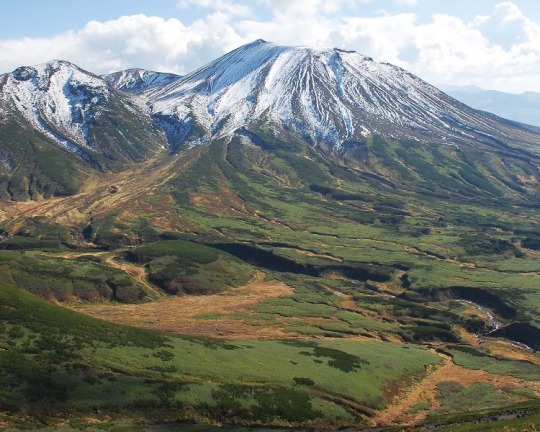
大雪山(たいせつざん)
北海道の名所
大雪山(たいせつざん)は北海道中央部に位置する山岳地帯で、日本百名山にも選定されています。以下に、大雪山の特徴と魅力を紹介します。
1. 標高
北海道内では最高峰の旭岳(あさひだけ)を含む大雪山連峰は、標高2,000メートル以上の山々からなります。
2. 登山スポット
多くの登山ルートが整備されており、登山家やハイカーに人気のエリアです。特に旭岳への登山が有名です。
3. 絶景の眺望
山頂からは北海道の自然景観を一望でき、特に天候が良い日には富良野や旭川までの景色が見渡せます。
4. 四季折々の魅力
春の新緑、夏の高山植物、秋の紅葉、冬の雪景色と、季節ごとに異なる美しい景色が楽しめます。
5. 自然保護区
大雪山は自然保護区に指定されており、多様な植生や動物相が生息しています。
6. アウトドアアクティビティ
トレッキングやクライミング、スキーやスノーシューなど、四季を通じたアウトドアアクティビティが楽しめます。
♪♫♬🎤🎹🎶♪♫♬🎤🎹🎶♪♫♬🎤🎹🎶♪♫♬🎤🎹🎶
Taisetsuzan
Famous places in Hokkaido
Taisetsuzan is a mountainous region located in central Hokkaido, and has been selected as one of Japan's 100 Famous Mountains. Below, we will introduce the characteristics and charms of Daisetsuzan.
1. Elevation
The Daisetsuzan mountain range, which includes Hokkaido's highest peak, Mt. Asahidake, consists of mountains over 2,000 meters above sea level.
2. Climbing spot
The area is popular with mountaineers and hikers, with many mountain climbing routes. It is especially famous for climbing Mt. Asahidake.
3. Spectacular view
From the top of the mountain, you can see a panoramic view of Hokkaido's natural scenery, and on particularly good days, you can see as far as Furano and Asahikawa.
4. Charm of each season
You can enjoy beautiful scenery that changes with each season: fresh greenery in spring, alpine plants in summer, autumn leaves, and snowy landscapes in winter.
5. Nature Reserve
Daisetsuzan is designated as a nature reserve and is home to a wide variety of flora and fauna.
6. Outdoor activities
You can enjoy outdoor activities throughout the year, such as trekking, climbing, skiing, and snowshoeing.
0 notes
Text
I used to wonder why foxes - red foxes in anime are most often depicted as white or blond and sometimes light brown whereas in western literature are often depicted with rich rusty red or bright orange fur. Orange foxes do exist in anime, but not as common as white and flaxen-furred foxes. I knew not to let the species term fool me as I was aware of the existence of albino, leucistic, and melanistic(silver and black) foxes a long time ago as well as the color mutations of domesticated red foxes. However, I also knew that red foxes can vary in color in the wild as well in various parts of the Earth. I can understand why most kitsune are drawn with gold to white fur. I have seen photos of foxes in Japan and a lot of them are pale or brown. The foxes at the famous Zao Fox Village are probably not native to Japan. A lot of them look like they were rescued from fur farms where they were bred with color variants(including marble, silver, and pearl). The rest of them look like red foxes from North America as shown here:

However, there is the subspecies in Hokkaido known as the Ezo fox that does not look much different:

Otherwise, most foxes in Japan seem to look like this:

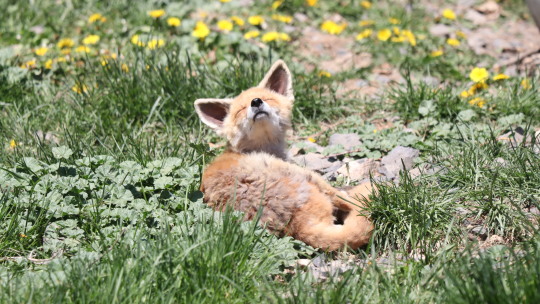

They appear to have a top coat that can shed in the Summer which is sort of similar to their arctic cousins. Many of the red foxes with the more classical red coat with prominent markings with the black feet and white-tipped tail are most common in Europe and North America.


However, they don't all look the same in these regions. I have seen photos of red foxes in Wyoming and Alaska where many of them can have pale fur that tends to be long. There are even red foxes with light-colored fur in the eastern U.S. I have seen one before here in Tennessee.
305 notes
·
View notes
Text
Fun fact:
Sapporo, Japan is known for its beer.

And skiing, Sapporo is known for its winter sports. They hosted the Olympics there once.
Hokkaido, the province where the city of Sapporo is located, is also famous for hot springs.
Hoping we see teasers next month.
76 notes
·
View notes
Text
When you're a tiny nematode, electrical fields are positively uplifting. Literally.
The most famous nematode of all – Caenorhabditis elegans – has been caught using electrical fields to its advantage. The tiny worm can somehow piggyback on electrical fields to jump a surprising distance, across a petri dish, for example, or onto the back of a bumblebee for a ride to a new locale.
It's not entirely clear how the nematodes do this, but thanks to an experiment led by biologist Takuya Chiba of Hokkaido University in Japan, it's now apparent that these tiny animals use electrical fields to disperse far afield into new habitats.
"Pollinators, such as insects and hummingbirds, are known to be electrically charged, and it is believed that pollen is attracted by the electric field formed by the pollinator and the plant," says biophysicist Takuma Sugi of Hiroshima University in Japan, co-senior author on the study.
Continue Reading
178 notes
·
View notes
Text
SNOW MIKU 2024 サブビジュアル

SNOW MIKU 2024のサブビジュアル(SDイラスト)を担当させていただきました。
「ごちそう」をテーマに、北海道の名産グルメを手にした給仕姿の皆さんをデザインさせていただきました。
※ミクとラビット・ユキネのデザインはshiro様によるものです。
※他5名はミクの衣装を軸にそれぞれのキャラクターに合わせてデザインしています。
I was in charge of the sub-visual (SD illustration) for SNOW MIKU 2024. Under the theme of “feast,” I designed a group of people dressed as waiters with Hokkaido’s famous gourmet foods in their hands.
*Miku and Rabbit Yukine were designed by shiro.
*The other five designers are based on Miku’s costume, and were designed to fit their respective characters.
━━━━━━━━━━━━━━━━━━━━━━━━━━━
無断転載・無断使用を禁じます。SNS等に画像を保存して投稿するのはおやめください。
Please do not save and post the images on social networking sites.
━━━━━━━━━━━━━━━━━━━━━━━━━━━
・SNOW MIKU 2024 公式サイト
62 notes
·
View notes
Text
Conan the Movie 27: The Million Dollar Signpost (First synopsis)
Hakodate, Hokkaido, known in Japan as "The million dollar night view city"

Phantom Thief Kid traveling here. to steal a mysterious treasure. But the obstacles that stand in his way are Conan and Hattori. Hattori who came for the purpose of confession to his childhood crush, Kazuha. Hattori is still angry that Kid thwarted his plan to give Kazuha a kiss. still waiting for time to payback (Based on Kid vs. Komei: The Targeted Lips)

Mouri Ran also expects Heiji to confess his love to Kazuha. But the obstacle that stands in their way is Ooka Momiji, a high school student who still hopes to win Heiji's heart after failing in the Osaka competition last time. (Based on the movie 21 The Crimson Love Letter)

Momiji took Muga Iori, a personal butler who used to work for the PSB. Same organization as Amuro and Scotch and saved her life when she was a kid. Including Shinichi's unfailing heart rival, Okita Soshi, who seems to be interested in Ran (Based on The Scarlet School Trip)
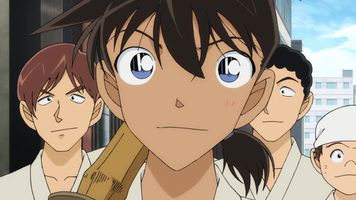
Okita Soshi's still hopes to get new match challenge with Heiji after helping solve the mystery and not being able to compete in kendo tournament, last time (Based on The Kendo Tournament of Love and Mystery, which is the first episode where Momiji first appeared before Movie 21)

Snow and blowing snow, dangerous cold settles in, but the worst is coming!!! Mysterious things have happened in the five-point fort "Goryokaku", the tomb of the legendary Shinsengumi.

Kid doesn't just have to deal with Heiji. But he still challenges Conan to solve the mystery.
With lives at stake!!
Heiji vs. Kid Thief

Conan vs. Okita

Ran and Kazuha vs Momiji and Iori

A hidden mystery that comes with a precious hidden love. Than the treasure was begin In this famous port city worth 1 millions dollars, Hakodate.

A work celebrating the 30th anniversary of the Detective Conan manga!!!!
Written by Takahiro Okura, who has made famous odd-numbered films (21, 23, 25) together with Tomoka Nakaoka, making history for female directors once again since movies 23: The Fist Of Blue Sapphire, featuring Yugo Kanno, composer of the best soundtrack from the previous two Detective Conan Movies.

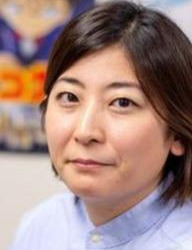
Conan the Movie 27: 1 Million Dollar Signpost
Release in Japan on April 12, 2024.
#mori ran#ran mori#meitantei conan#detective conan#dcmk#case closed#case closed anime#movie 27#m27#kudo shinichi#mouri ran#shinichi kudo#ran mouri#hattori heiji#heiji hattori#edogawa conan#conan edogawa#kaito kid#kuroba kaito#kaito kuroba#kazuha toyama#okita soshi#momiji ooka#The Million Dollar Signpost
57 notes
·
View notes
Note
(this is spacekrakens lmao) dude idk anything about like 1950s Japanese cinema, do you have any recommendations? looking for stuff to toss on the watchlist now that I'm a bit burned out on horror (unless you have some horror recs)
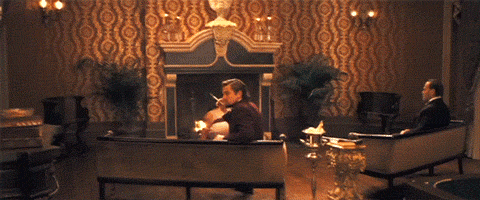
Hey! If you’re curious about Japanese cinema (particularly 1950s), there’s a lot of avenues to explore! Musicals, crime, horror, historical—it all depends on what mood you’re in. (Putting this under a read more because I'm DEFINITELY going to be long posting about this!!!) Hope this is useful to you lol.
(Also noting if anybody wants to add to this list with their own recommendations feel free!!)

With old school Japanese cinema, I’ll always recommend Akira Kurosawa (obviously). He’s made some of the best Japanese movies (and arguably, the best movies of all time imo) and I feel like his work is a good gateway. It’s readily available on physical media/streaming too.
Specifically ‘50s stuff; Hidden Fortress (1958) is a good adventure flick whose structure was swiped for Star Wars, Throne of Blood (1957) is Japanese Macbeth if you like Shakespeare, and if you don’t mind a longer movie Seven Samurai (1954) includes Toshiro Mifune acting like this;
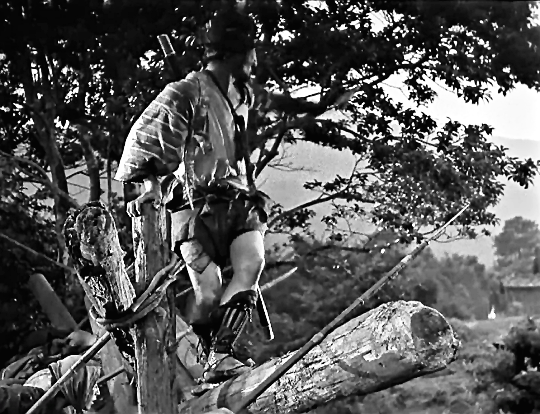
Gotta admit, though—my personal favorites from Kurosawa don’t come from the 1950s; Drunken Angel (1948) and Yojimbo (1961). One has a pathetic gangster as the main lead, the other is just a solid, breezy proto-action film (also has my beloved Unosuke but that's besides the point)
Some personal favorites of mine from the 1950s:
Life of a Horse Trader (1951) is a bittersweet story about a man trying to be a good single father to his son in the backdrop of Hokkaido. He tends not to be great at it. Stars Toshiro Mifune, the most famous face of Japanese cinema and for good reason!
Conflagration/Enjo (1958) is a single Buddhist acolyte’s fall into quiet insanity. Raizo Ichikawa is another amazing actor who I love! Also includes Tatsuya Nakadai who is the GOAT (in my heart).
Godzilla (1954) is AMAZING! If you liked Gozilla Minus One, it took a lot of familiar cues from this movie. It also technically counts as horror, depending on your definition.
Japanese horror from the 1950s:
Ugetsu (1951) (Not one I’ve seen personally, but it’s on Criterion)
The Beast Shall Die (1958) (American Psycho, but in Showa Japan. Tatsuya Nakadai is terrifying in this and absolutely despicable—stylish movie tho!)
Ghost of Yotsuya (1959) (Old-school Japanese ghost story. Honestly, there are so many different versions of this story on film that you can pick which version to watch and go from there—I’m partial to the 1965 version myself, because of the rubber rats and Tatsuya Nakadai playing a crazy person).
The Lady Vampire (1959) is the OG western-style vampire movie from Japan. Plays around with the mythos a lot, but hey our Dracula looks like this;

Misc movies that I think are neat or good gateway movies:
The Samurai Trilogy by Hiroshi Inagaki, which stars Toshiro Mifune as Miyamoto Musashi. Found that people otherwise uninterested in Japanese cinema really enjoyed this!
You Can Succeed, Too (1964) is one of my favorites from the ‘60s, also directed by Eizō Sugawa. A fun satire on the corporate world that's super colorful with catchy songs.
The Sword of Doom (1966) is also another favorite of mine, starring my beloved Tatsuya Nakadai as another bastard man (seriously though Ryunosuke is FASCINATING to me--). Fun gore effects and action scenes!
Kwaidan (1964) is an anthology of Japanese folk tales, labeled a horror film but in that kinda sorta old-school way. Beautifully shot by my favorite Japanese director Masaki Kobayashi (who, if you like this you should seriously check out his other work!)
#thanks for the ask!#akira kurosawa#tatsuya nakadai#toshiro mifune#raizo ichikawa#japan#film#godzilla#hidden fortress#seven samurai#drunken angel#yojimbo#enjo#sword of doom#kwaidan#you can succeed too#samurai trilogy#the lady vampire#ghost of yotsuya#ugetsu#life of a horse trader#throne of blood#ask
22 notes
·
View notes
Text
福島県
Japanese Prefectures: Tohoku - Fukushima
都道府県 (とどうふけん) - Prefectures of Japan
Learning the kanji and a little bit about each of Japan’s 47 prefectures!
Kanji・漢字
福 フク blessing, fortune
島 しま、トウ island
県 ケン prefecture
東北 とうほく north-east, Tohoku (northernmost six prefectures of Honshu)
Prefectural Capital (県庁所在地) : Fukushima (福島市)
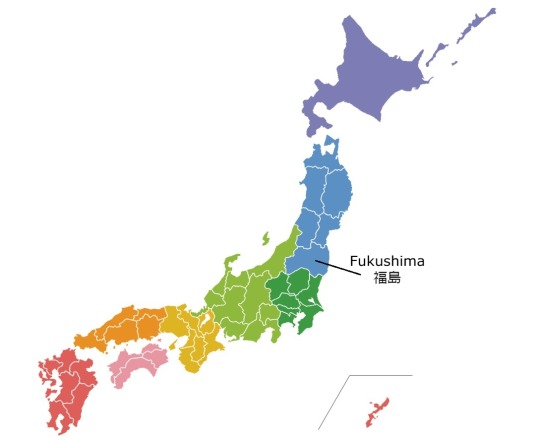
Fukushima is the third largest prefecture of the 47 prefectures of Japan and stretches between the mountainous interior of Northern Honshu to the Pacific Ocean. Like most of the other Tohoku prefectures, Fukushima boasts expansive natural beauty, relaxing hot springs, a rich history, and excellent ski resorts. The feudal Aizu Clan, of the still-standing castle town of Aizu-Wakamatsu, remained loyal to the shogun, even after the shogun was removed from power during the Meiji Restoration. This loyalty led to the Aizu area becoming a battleground of the Boshin War in 1868, where those loyal to the shogun were pushed northwards into Tohoku and Hokkaido as they resisted the reformers and those loyal to the emperor. The Aizu area boasts the post town of Ouchijuku, with buildings retained from the samurai era; Tsuruga Castle; hot springs; and a famous sake brewery.
The March 2011 earthquake and tsunami devastated the coastal areas of Fukushima Prefecture and caused a nuclear accident at the Fukushima Daiichi Nuclear Plant. Tens of thousands of residents were evacuated and a no-entry zone was set up around the nuclear plant. The no-entry zone makes up less than 3% of the prefecture's area, and even inside most of the no-entry zone, radiation levels have declined far below the levels that airplane passengers are exposed to at cruising altitude. Thus Fukushima has been deemed safe for tourists to visit. Wide areas of western Fukushima, in particular, escaped much contamination, including the mountainous interior around the historic city of Aizu-Wakamatsu. And even in most of the eastern parts of the prefecture, radiation levels have by now decreased to pre-2011 levels due to natural decay and decontamination efforts.
Recommended Tourist Spot・おすすめ観光スポット
Ouchijuku - 大内宿
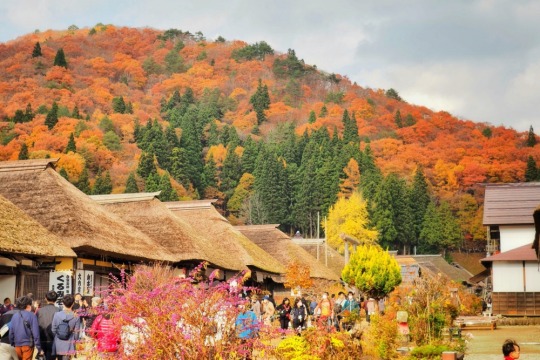
Photo by JR Times
If you want a taste of Edo Period Japan, Ouchijuku is the place for you. This is a former post town along the Aizu-Nishi Kaido trade route, which connected the centers of Aizu (a former castle town to the north in Fukushima) and Nikko (to the south in Tochigi prefecture) during the Edo Period. Restrictions set by the shogunate required travelers to make the journey on foot, and thus post towns such as Ouchijuku developed along the route to provide food, accommodation, and rest. Ouchijuku has been restored to look as it did in the Edo Period, with thatched roof buildings that house a variety of shops, restaurants, and minshuku (small traditional Japanese inns).
The former Honjin, or principal inn for high ranking government officials, is currently a museum, offering an example of elegant traditional housing interiors of the Edo Period and includes a collection of dishes, clothing, and other artifacts.
The Takakura Shrine is a five minute walk off the main path and hosts a unique purification fountain in the midst of a stand of Japanese cedar trees, and was dedicated to Prince Mochihito, who died in June 1180. Near the beginning of the Genpei War (1180-1185) during the Battle of Uji, the prince fled to the Phoenix Hall of the Byōdō-in temple, where he was later captured and killed at the torii gate of Kōmyōsan. It was said that he managed to escape, and hid in Ouchijuku.
Shohoji Temple is located at the end of the main street and up a steep flight of stairs. At the top of the path visitors can enjoy a panoramic view of Ouchijuku and its surroundings.
Regional Cuisine - 郷土料理
Kitakata Ramen - 喜多方ラーメン
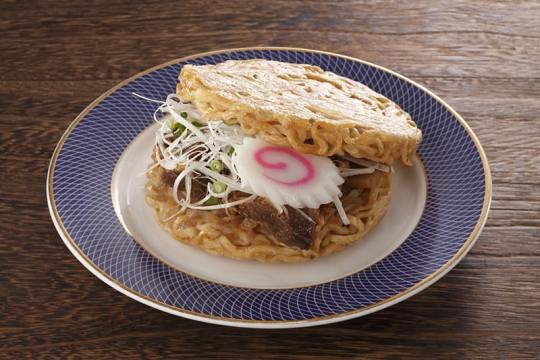
Photo by JR Times
Kitakata ramen is a gourmet specialty from Kitakata, Fukushima prefecture. The origin of these noodles is said to be from Chinese noodles sold in stalls by young people who had come from China from 1920-1930. The noodles are thick and flat with a firm appearance and texture and a relatively high moisture level. The soup is a soy base, with flavors varying depending on the shop, from miso to salt. To determine where to eat, there is a Ramen Map located at the tourist information center in Kitakata.
The popular Kitakata Ramen Burger is made from baked and hardened noodles together with pork, menma, and green onions. Kitakata is also known for its unique culture of eating ramen early in the morning. People who started work very early in the morning at sake breweries and on farms would eat ramen early in the morning, and thus the habit began. "Morning ramen" is available at many shops in the area.
Fukushima Dialect・Fukushima-ben・福島弁
Fukushima-ben or the dialect of Fukushima is similar in some ways to the other Tohoku (or North-East Japan) dialects, but also has some key differences. Here are some interesting phrases I found.
洗濯物をおっこむ (sentakumono o okkomu)
Standard Japanese: 洗濯物を取り込む (sentakumono o torikomu)
English: to take in the laundry
ぶっちめた (bucchimeta)
Standard Japanese: ぶつけた (butsuketa)
English: to hit (e.g. one's head)
すっぺったこっぺった (suppetta koppetta)
Standard Japanese: ごちゃごちゃ言うな (gocha gocha iu na)
English: don't complain about it
うっちしい (ucchishii)
Standard Japanese: うるさい (urusai)
English: noisy, annoying
#japanese prefectures#日本語#japanese#japanese language#japanese langblr#langblr#studyblr#都道府県#福島県#fukushima
85 notes
·
View notes
Text
The Ezo Red Fox
The Ezo red fox (Vulpes vulpes schrencki) is a subspecies of red fox seen mainly between the Hokkaido, Sakhalin, the Kuril Islands

The Ezo red fox's formal name, Kitakitsune (北狐), was given to the subspecies by Kyukichi Kishida when he studied them in Sakhalin in1924
These are not the same foxes you’ve seen from the famous “fox island” (located in Shiroishi) in japan, and are not usually friendly towards humans. They are also slightly larger than other species of fox in japan.
#Exo Red Fox#Red Fox#Fox#Foxes#Japan#Japanese Foxes#Kitsune#Mostly from wikipiedia#just doing some research and thought I'd share#I LOVE foxes
170 notes
·
View notes
Text
It’s once again time for me to talk about the real-life inspirations for every fish Pokémon. Today I’ll be covering generations V and VI. For previous generations check here and here.
The Unova games were the first ones I played and so a lot of the gen V Pokémon are special to me. This is not the case for Basculin. These stupid fish made any time spent on the water a living hell and they don’t even have the decency to evolve into something good like Zubat. Basculin was added to the Unova dex last minute to fill out the fish archetype and they really shouldn’t have bothered as this Pokémon is pretty garbage. But wait, what’s this? BAH GAWD IT’S HISUI WITH AN EVOLUTION! Basculegion redeems white-striped Basculin as a concept by giving it a pretty awesome evolution. Only white-striped Basculin though, red and blue still stink since they can’t evolve. Anyway, they’re bass, most likely largemouth bass as they are large, predatory, and the dex entries say they put up a hell of a fight when hooked. Largemouth bass are a very common predatory fish in north America and have been introduced to freshwater systems around the world due to them being incredibly popular amongst anglers for the fight they put up. This has led to them becoming invasive species in many regions, which could be why Basculin can be found in every region since Unova.
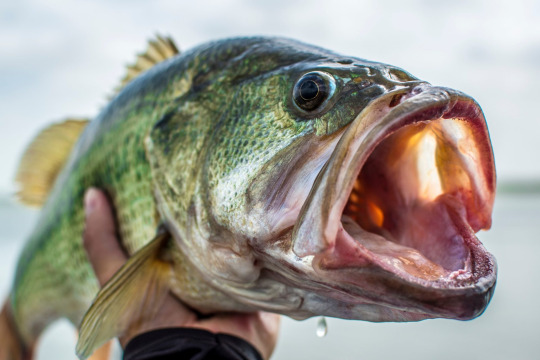
AAAAAAAAAAAAAAAAHHHHH (image: a largemouth bass)
Basculin’s aggressive nature could be based on common misconceptions about piranhas (see the gen III entry for more info about that) and their different colors and habit of fighting each other could be based on bettas, which are famous for being colorful and ready to throw down at the drop of a hat. The color differences of the Basculins could be based on allopatric speciation. This is when a population gets split by some geographic feature and the populations on each side start developing differently to each other. If that is the case, all I can say is that the Shellos line did it better. White-striped Basculin takes the same inspirations as red and blue and adds in salmon. Like salmon, they swim up rivers to spawn and their jaws have points like kypes, those weird jaw hooks that male salmon get.

Puberty hits the salmon the way Godzilla hit Tokyo (image: a male salmon in breeding season)
Basculegion continues the salmon trend of white-striped Basculin, while also adding some Ainu inspiration. Ainu legend has the ciray, a gigantic salmon or taimen (a salmon relative) that can eat deer and boars. It also drawn influence from a type of Ainu boat called the itaomacip, hence its use as a ride Pokémon in Hisui. The Ainu are indigenous people hailing from Hokkaido, the Japanese island that inspired Hisui. Basculegion status as a combination of fish souls may be inspired by schooling fish, though in this case the whole school is one fish. I also think it has some definite inspiration from decorative carp streamers. The color differences between male and female Basculegion is inspired by the sexual dimorphism in salmon and relatives. Both sexes change color during mating season, but males become much more vibrant than females. Wow, I did not think I would have this much to say about Basculin.
Alomomola should be the long-needed evolution for Luvdisc, but it isn’t. Hell, the devs know it should be an evolution and teased us by putting Luvdisc in Alomomola’s Paldea pokedex picture. It’s a mola mola, also known as the ocean sunfish. I mentioned these previously while discussing Sharpedo. They are gigantic and weird animals that look like somebody chopped the back half off of a fish.

(image: an ocean sunfish)
like Alomomola, the mola is a gentle giant that moves slowly and is basically incapable of actually hurting anything. The sunfish’s diet consists largely of jellyfish, which is why Alomomola lives in the same places as the Frillish line. Its fins look like hands and its body looks like a heart, making it a possible reference to the Claddagh ring, an Irish symbol consisting of two hands clasping a crowned heart, representing love, loyalty, and friendship, fitting for a defensive support Pokémon. Alomomola’s tendency to wrap itself in a protective membrane is likely a reference to parrotfish, who incase themselves in a protective mucus cocoon when sleeping. Alomomola’s role as a healer fish may be inspired by cleaner fish (who clean parasites and dead skin off of larger fish, something that molas often need) and the red garra, a fish often used in spas to eat dead skin off of people’s feet.
What’s this? A non-water type fish? Yes, it’s the Tynamo line. Anyway, these fellows have an interesting inspiration. They’re based on lampreys and electric eels, two animals that are often called eels but aren’t. Electric eels are a genus of knifefish while lampreys aren’t even fish. Maybe. This gets complicated. Starting simple, electric eels are famous for their ability to generate electricity, though this isn’t unique to them. The ability of an animal to generate electricity is called electrogenesis and it is usually used to detect prey by creating an electric field and then sensing changes in the field. A few animals take this farther by generating enough electricity to stun or kill prey and potential predators. Electrogenesis and electroreception are mostly seen in aquatic animals as water is a much better conductor than air. Electric eels are easily the most famous electric fish, capable of delivering very painful shocks to humans. Studies on it appear to have influence some very important inventions in the study of electricity. Electric eels are also obligate air-breathers, being incapable of breathing water. This could be a reason why the Tynamo line live outside of water.
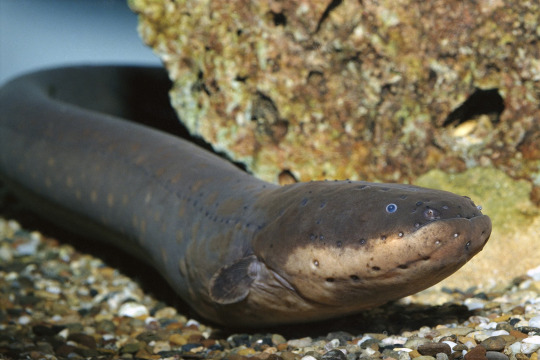
More like EELectric, am I right guys? ...Guys? (image: an electric eel)
Lampreys are also capable of electroreception, though they can’t generate shocks like electric eels. Lampreys are some of the only surviving agnathans, a group commonly known as the jawless fishes for pretty self-evident reasons. Most agnathans went extinct due to competition from jawed fish (gnathostomes) but the lampreys and hagfish managed to hold on. Lampreys are famous for their conical mouths, which they use to suction onto things. While the Tynamo line are based on the more famous parasitic lampreys, who suction onto other fish to drink their blood, the majority of lamprey species are harmless algae-eaters.

Gimmie a kiss (image: a lamprey, mouth toward the camera)
Tynamo is distinct from its later forms in that it looks like a leptocephalus larva, a type of fish larva known for a body plan that looks like a transluscent leaf with a head on one end. Leptocephalus larvae are found in fish of the superorder elopomorpha, which includes eels among others. So an eel larva evolves into a combination of to animals that are often called eels but aren’t. I love it.

(image: a leptocephalus larva)
Tynamo may also be based on early lightbulbs like the Crookes tube. The lamprey brings up to the complicated question of “what is a fish?”. From the standpoint of a fisherman, a fish is any scaly thing with gills that lives in the water, but when you look at things from a taxonomic viewpoint, it’s much more complicated. Because you can’t evolve out of your ancestry and belong to any categories your ancestors belonged to, any attempt to classify all scaly things with gills that live in the water in the same clade results in every vertebrate falling under the fish classification. This is why, to taxonomists, there is no such thing as a fish. it’s simply not possible to put bony fish, cartilaginous fish, and jawless fish in a category together without making that category so overly broad it isn’t useful.
It’s flat fuck Friday and I’m talking about Stunfisk. Its biggest influence seems to be the flounder, the most famous of the flatfish, though flounders lie on their side and stunfisk lies on its underbelly.

(image: a flounder)
Because of this, it likely also draws influence from stingrays, particularly the electric rays, which can release an electric shock to stun prey similarly to the more famous electric eel. This would explain the electric typing.

It's shocking! (image: an electric stingray)
Both Unovan and Galarian Stunfisk live in wet, muddy areas but don’t necessarily live in water. This makes me think of fish that can live both in and out of the water, like walking catfish, mudskippers, and lungfish. These fish can often breathe air and can spend much of not most of their time on land, though they generally must stay in wet environments like beaches and mud puddles. Both forms of Stunfisk are ambush predators, but they employ different strategies. Unaovan Stunfisk simply buries itself under mud and waits for prey to step on it before delivering a shock. Galarian Stunfisk is somewhat more active as it uses aggressive mimicry to actively lure prey in. Disturbingly, it uses a mouth colored like an item ball to lure in prey, suggesting it may be specialized to attract and prey on humans. Because Galarian Stunfisk doesn’t have the electricity generating organs of its Unovan cousins, it relies on strength to take down prey, clamping shut with modified fins that are based on a bear trap.
Moving on to gen VI, we have the Skrelp line. These are based on the weedy seadragon, a relative of the seahorse and pipefish. Like its inspiration, Skrelp relies on defensive mimicry for survival, camouflaging itself as seaweed to avoid predators, and its tail is not prehensile like a seahorse’s would be. Once it evolves, it becomes more of a leafy seadragon, another seahorse relative of seahorses that uses the same defensive mimicry, but it much more elaborate in appearance. However Skrelp and Dragalge are poison-types and I could find no examples of poisonous or venomous seahorses or sea dragons. That being said, there is a possible inspiration for their poison typing. The line is specifically stated to live around rotting seaweed, which emits hydrogen sulfide and ammonia, both of which are toxic to humans and many other animals in high enough doses. Like with Kingdra, Dragalge’s dragon tying comes from the Japanese word for seahorse: “tatsu-no-otoshigo”, which means “dragon’s child”.
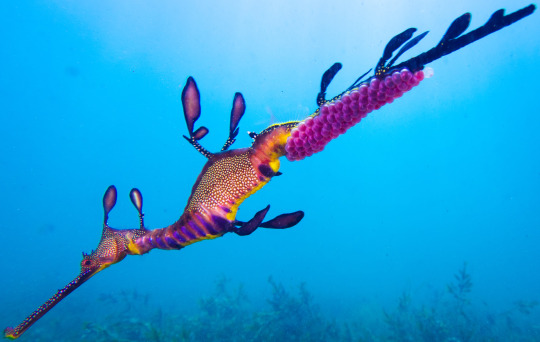
(image: a male weedy sea dragon carrying his eggs)

(image: a leafy sea dragon)
Next time I'll cover gens VII and VIII. Gen IX will probably get its own post as there are a surprising amount of fish in Paldea
88 notes
·
View notes
Text
日本のトリビアまとめ #0029

#日本のトリビア#十勝岳(とかちだけ)#Famous places in Hokkaido#Shiretoko Five Lakes#Akan Mashu National Park#知床五湖#Tokachidake (Tokachidake)#北海道の名所#Japanese Trivia#羊蹄山(ようていざん)#阿寒摩周国立公園#Mt. Yotei
0 notes
Photo

支笏湖温泉(しこつこおんせん)
北海道の名所
支笏湖温泉(しこつこおんせん)は、北海道の支笏湖周辺に点在する温泉地で、自然豊かな湖畔に湧く温泉が魅力です。以下に、支笏湖温泉の特徴と魅力を紹介します。
1. 透明度の高い湖水
支笏湖はその透明度が高く、その美しい湖面が自然を象徴しています。
2. 湖畔の温泉施設
湖畔にはホテルや旅館が点在し、豊富な種類の温泉が楽しめます。泉質は硫黄泉やナトリウム-塩化物泉などがあります。
3. 景観とアウトドアアクティビティ
湖畔の散策や自然を楽しむトレッキングコースが整備されており、四季折々の美しい景色を楽しむことができます。
4. 支笏洞爺国立公園
支笏湖周辺は支笏洞爺国立公園に指定されており、自然保護区域として多様な生態系が保護されています。
5. 釣りやカヌー
湖での釣りやカヌーなどの湖水レジャーが楽しめます。
♪♫♬🎤🎹🎶♪♫♬🎤🎹🎶♪♫♬🎤🎹🎶♪♫♬🎤🎹🎶
Lake Shikotsu Onsen
Famous places in Hokkaido
Lake Shikotsu Onsen (Shikotsuko Onsen) is a hot spring resort dotted around Lake Shikotsu in Hokkaido, and is famous for its hot springs that gush out on the shores of the lake, which are rich in nature. Below, we will introduce the characteristics and charms of Lake Shikotsu Onsen.
1. Highly transparent lake water
Lake Shikotsu is highly transparent and its beautiful surface symbolizes nature.
2. Lakeside hot spring facility
Hotels and inns are dotted around the lake, and you can enjoy a wide variety of hot springs. The spring quality includes sulfur springs and sodium-chloride springs.
3. Landscape and outdoor activities
There are lakeside walks and trekking courses to enjoy nature, allowing you to enjoy the beautiful scenery of each season.
4. Shikotsu-Toya National Park
The area around Lake Shikotsu is designated as Shikotsu-Toya National Park, where a diverse ecosystem is protected as a nature conservation area.
5. Fishing and canoeing
You can enjoy lake leisure activities such as fishing and canoeing.
0 notes
Text
Lupin Sansei or: How I Learned to Stop Worrying and Love the World
Hi! A friend has allowed me to post their fanfic and has requested to stay anonymous.
This fanfic details the events after Shin Lupin III and is written in the perspective of Monkey Punch, much like the mini novel "Lupin III, the Dream-eating Adventurer." I hope you enjoy my friend's work!

“Last Wednesday the news was made public. Lupin the Third and his gang had died in a horrible explosion in 1981. They really waited a whole year to make this public.”
“Now, I ask you my dear readers… Why do you think this was like this? Bureaucracy? Press rights? No, nothing like that… They wanted to confirm it, they wanted to make it official that this man was dead…”
“But if you ask me, my dear readers, I don't believe any of that garbage, Lupin the Third is still alive…!!”
“I don't have any proof or any idea where he might be right now, but one thing I can know and say with certainty is that wherever you think he is, he's not there…”
“The last time I heard about him through the news was that the famous Detective Starmo from the United States had died... no, he had been murdered…”
“The news presumed that Lupin had been in the city of San Francisco for a full week or even a month, but I myself can tell you with my hand on my heart that one day, before seeing that news I saw him circulating on the borders of the town where I live: Hokkaido, Japan…"
“He and I are no longer what you could call strangers, but the last time I documented anything about him was during my short stay in New York."
“I saw him in a situation that was completely incomprehensible to me. He was simply buying fruits at the store I always go to. But this time I decided that I would be the one who would start everything, I would be the one who would start the conversation, but when I arrived, he was no longer there.”
“You saw him?” I asked the lady who owns the place. “Did you see that man? It was Lupin…!!!”
“As if it was a bad joke, the lady looks at me with a naive face and tells me that she doesn't know that man.”
“Now I ask you, my dear readers, how is this possible? How can a man steal the Statue of Liberty and then be forgotten from the collective consciousness?”
“In the time that I have been writing this diary, I have received many letters of admiration and appreciation, people casually tell me that they love my character… Now, I need to leave something very clear, this man is real, he's not fiction, Even I had trouble accepting that I live in the same reality as him, but yes, I can confirm and maintain without a doubt in my soul that Lupin the Third is real.”
“This does not mean that with his death the stories in this diary have ended, not at all, my dear readers, I still have many experiences to tell about him.”
“Why? You see, at the moment I left the store already disappointed, after trying to make the lady understand the seriousness of the situation she had just experienced, she interrupts me and says:
“That boy, Lupin, left you a piece of paper. He told me to give it to you.”
...
“I have big plans, I want you to pay attention to the world.”
The End.
13 notes
·
View notes